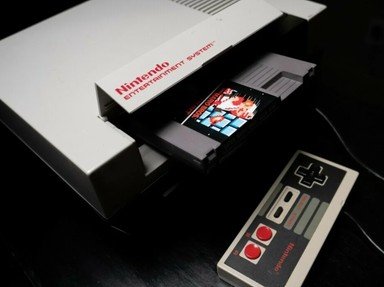Quiz Answer Key and Fun Facts
1. Game 30: Ah yes, the original "Mega Man"! In the first stage of Dr. Wily's fortress, you must use the Magnet Beam to climb up to a ladder. What weapon do you use to obtain the Magnet Beam?
2. Game 29: "Adventure Island II" is a platforming game which features Master Higgens, the game's principal protagonist, riding on dinosaur and predates Mario riding on Yoshi in "Super Mario World" by several months. However, the idea of Mario riding a dinosaur predates actually "Adventure Island II". Shigeru Miyamoto originally envisioned Mario to riding a dinosaur in what title?
3. Game 28: "Baseball Stars" may be the most important video game of Baseball ever released. If at the end of any inning one team is up a total of a certain amount of runs, they automatically win the game. How many runs do they have to be up by?
4. Game 27: "Kirby's Adventure" is the second largest game in megabits (not megabytes) on the NES as far as data goes. What is the largest NES game in data terms?
5. Game 26: Originally released in 1987 on the MSX2, "Metal Gear" came Stateside in 1988. There are numerous differences between the MSX2 version and the NES version, including the opening stage. How does the MSX2 version open?
6. Game 25: "Castlevania II: Simon's Quest" has become rather infamous in the past few years due to a certain online video game reviewer. The game is actually the third "Castlevania" game developed by Konami. What is the second Castlevania game in the series?
7. Game 24: The officials in "Blades of Steel" call how many penalties?
8. Game 23: In 1996, Taito announced they lost the source code to what classic NES title?
9. Game 22: "Blaster Master" is a story of a boy, his frog, a hole in the ground, and radioactive waste. What other NES title reuses the majority of "Blaster Master"'s sound effects?
10. Game 21: "Zelda II: The Adventure of Link" is famous for being such a departure from the previous "Zelda" title. In the sixth issue of Nintendo Power (May-June 1989), Nintendo Power had their first annual Nestor Awards. "Zelda II: The Adventure of Link" captured the honor of winning the Best Overall Video Game of 1988. What other Nestor award did the game win in that same issue?
Source: Author
berenlazarus
This quiz was reviewed by FunTrivia editor
kyleisalive before going online.
Any errors found in FunTrivia content are routinely corrected through our feedback system.
